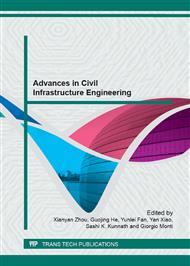p.648
p.652
p.657
p.665
p.670
p.678
p.682
p.688
p.694
Influence of Soil Consolidation History on Seismic Response of Underground Structure in Layered Liquefiable Ground
Abstract:
It is shown that liquefaction induced uplift is one of the most typical disasters for underground structures in liquefiable zone. Though a lot of researches were conducted to investigate the uplift phenomenon of underground structures in the past years, further studies need to be carried out to discover its mechanism because the seismic responses were correlated with many factors. In the paper, a fully coupled dynamic analysis was performed to investigate the dynamic responses of underground structure in layered saturated ground. The soils were simulated by a cyclic mobility constitutive model, which adopted some important concepts such as stress induced anisotropy, subloading yield surface, and superloading yield surface. It was verified that the constitutive model can perfectly describe the dynamic character of both liquefiable sand and non-liquefiable clay. Simulated results were obtained for excess pore water pressure and deformation of soil deposit and uplift of underground structure. Special emphasis was given to discuss the influence of soil consolidation history on the seismic responses of underground structure. Simulation indicated that with the occurrence of liquefaction, soils at lateral sides of underground structure flowed toward the bottom of the structure, which led to the uplift of structure. Results also showed that the excess pore water pressure ratio of liquefiable soil decreased with the increasing of soil pre-consolidation pressure. Then the liquefied zones diminished, and the uplift of underground structure reduced.
Info:
Periodical:
Pages:
670-677
Citation:
Online since:
January 2013
Authors:
Price:
Сopyright:
© 2013 Trans Tech Publications Ltd. All Rights Reserved
Share:
Citation:


